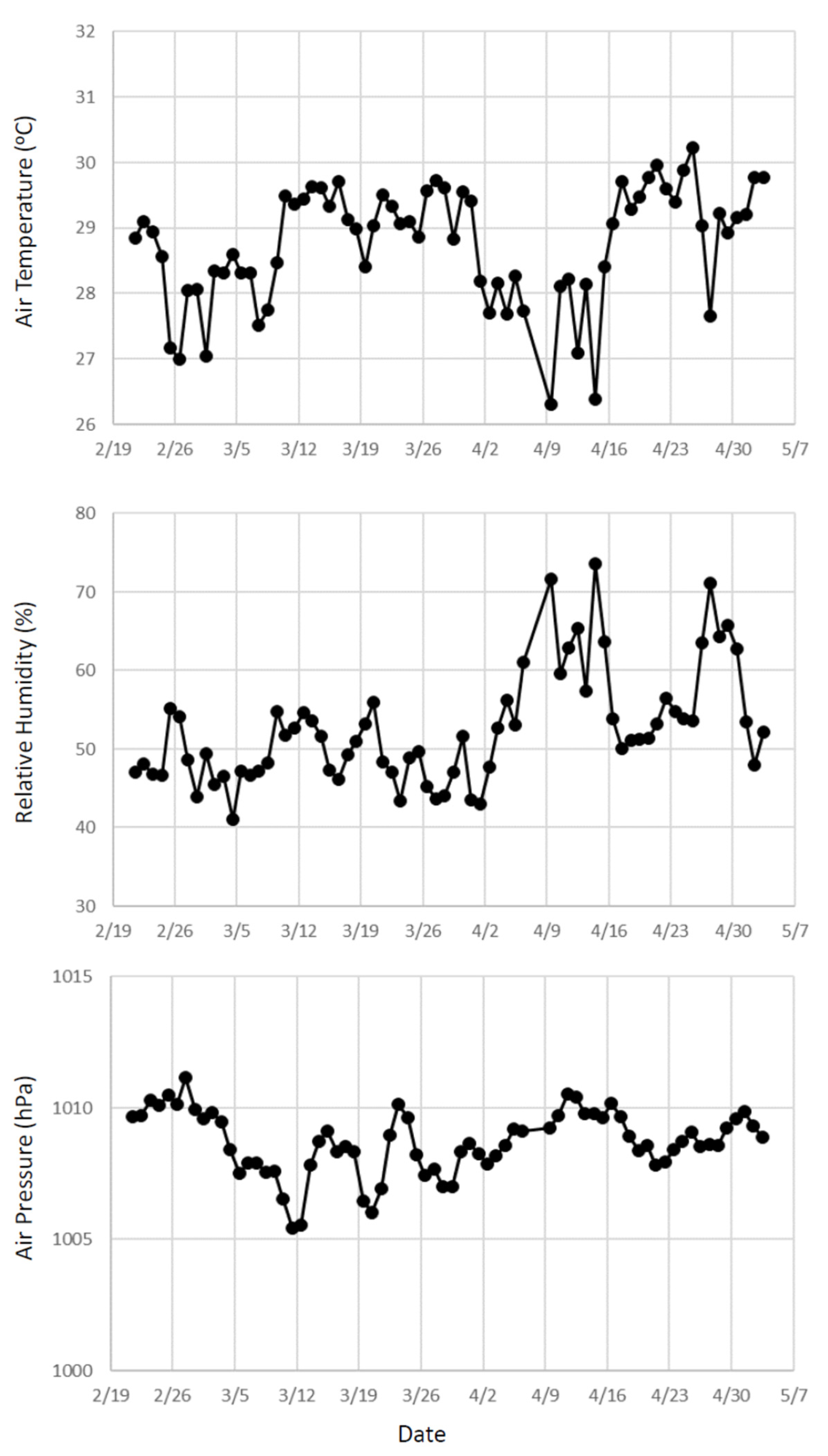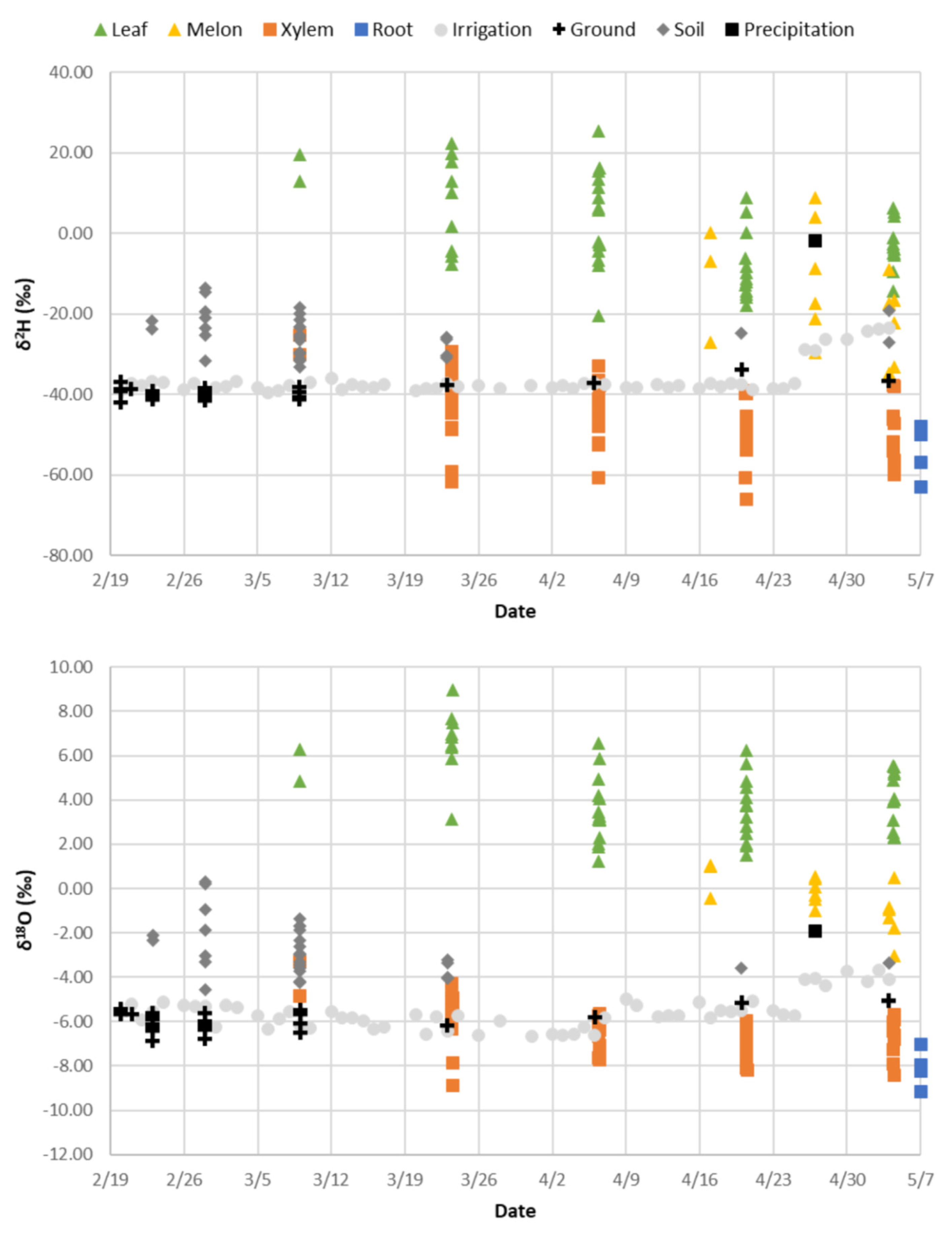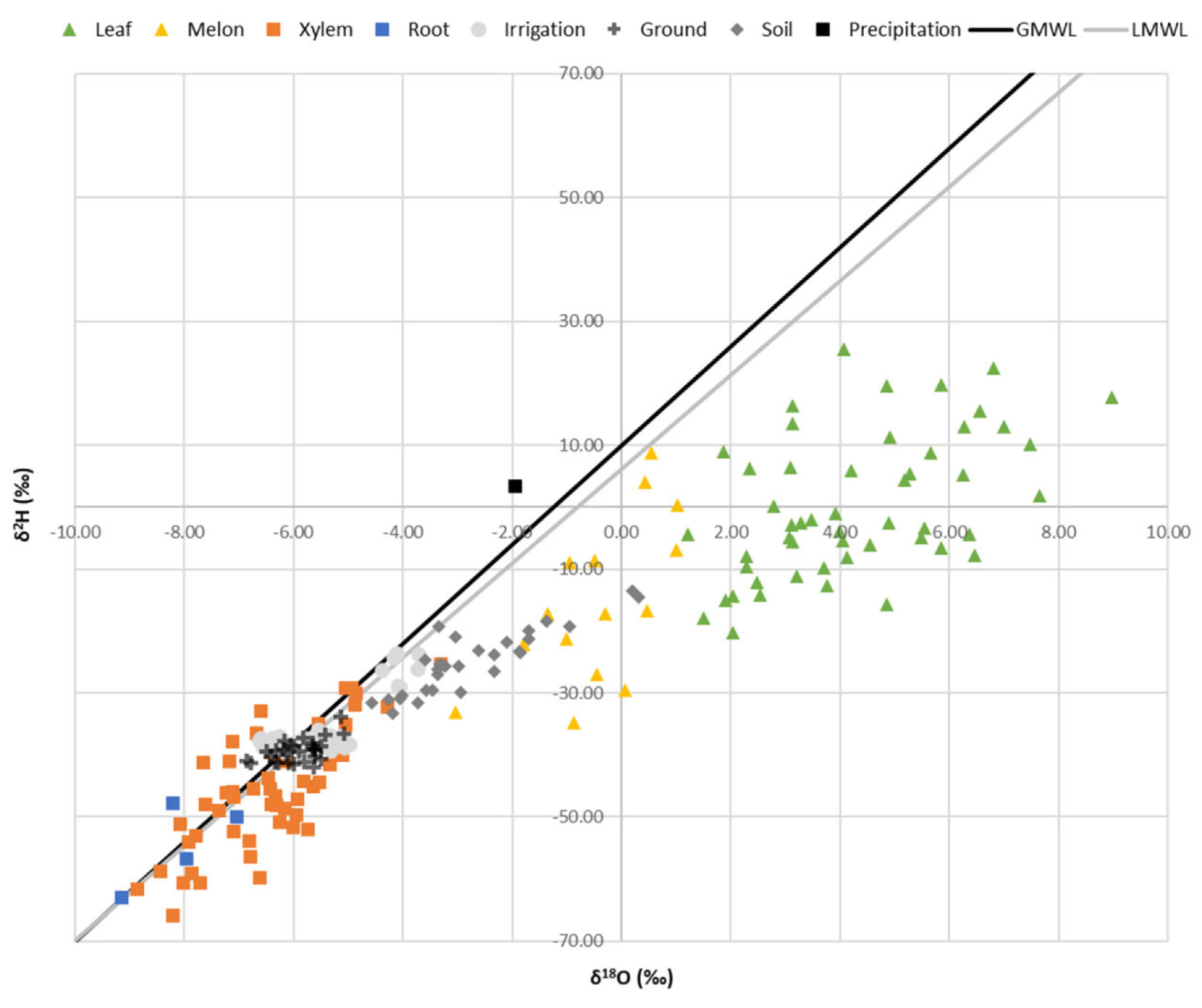On the Potential of Biochar Soil Amendments as a Sustainable Water Management Strategy
Abstract
:1. Introduction
2. Materials and Methods
2.1. Site Description
2.2. Experiment Design
2.2.1. Biochar and Melon Plants
2.2.2. Water Monitoring and Data Processing
2.2.3. Isotopic Sampling and Analysis
3. Results and Discussion
3.1. Hydrometric Observations
3.2. Isotopic Composition
3.3. Practical Implications
3.4. On the Potential for Stacked Benefits
4. Conclusions
Author Contributions
Funding
Institutional Review Board Statement
Informed Consent Statement
Data Availability Statement
Acknowledgments
Conflicts of Interest
References
- Sohi, S.P.; Krull, E.; Lopez-Capel, E.; Bol, R. Chapter 2—A review of biochar and its use and function in soil. In Advances in Agronomy; Academic Press: Cambridge, MA, USA, 2010; Volume 105, pp. 47–82. [Google Scholar]
- Fischer, B.M.C.; Manzoni, S.; Morillas, L.; Garcia, M.; Johnson, M.S.; Lyon, S.W. Improving agricultural water use efficiency with biochar—A synthesis of biochar effects on water storage and fluxes across scales. Sci. Total Environ. 2019, 657, 853–862. [Google Scholar] [CrossRef] [PubMed]
- Sundberg, C.; Karltun, E.; Gitau, J.K.; Kätterer, T.; Kimutai, G.M.; Mahmoud, Y.; Njenga, M.; Nyberg, G.; Roing de Nowina, K.; Roobroeck, D.; et al. Biochar from cookstoves reduces greenhouse gas emissions from smallholder farms in Africa. Mitig. Adapt. Strateg. Glob. Chang. 2020, 25, 953–967. [Google Scholar] [CrossRef]
- Liu, C.; Wang, H.; Tang, X.; Guan, Z.; Reid, B.J.; Rajapaksha, A.U.; Ok, Y.S.; Sun, H. Biochar increased water holding capacity but accelerated organic carbon leaching from a sloping farmland soil in China. Environ. Sci. Pollut. Res. 2016, 23, 995–1006. [Google Scholar] [CrossRef] [PubMed]
- International Biochar Initiative. Guiding Principles for a Sustainable Biochar Industry. 2012. Available online: https://biochar-international.org/sustainability-climate-change/ (accessed on 27 April 2022).
- IPCC. Climate Change 2014 Impacts, Adaptation, and Vulnerability Part B: Regional Aspects; Cambridge University Press: New York, NY, USA, 2014. [Google Scholar]
- Magrin, G.; García, C.G.; Choque, D.C.; Giménez, J.C.; Moreno, A.R.; Nagy, G.J.; Nobre, C.; Villamizar, A. Latin America Climate Change 2007: Impacts, Adaptation and Vulnerability. In Contribution of Working Group II to the Fourth Assessment Report of the Intergovernmental Panel on Climate Change; Parry, M.L., Canziani, O.F., Palutikof, J.P., van der Linden, P.J., Hanson, C.E., Eds.; Cambridge University Press: Cambridge, UK, 2007; pp. 581–615. [Google Scholar]
- Neelin, J.D.; Münnich, M.; Su, H.; Meyerson, J.E.; Holloway, C.E. Tropical drying trends in global warming models and observations. Proc. Natl. Acad. Sci. USA 2006, 103, 6110–6115. [Google Scholar] [CrossRef] [Green Version]
- Reyer, C.P.; Adams, S.; Albrecht, T.; Baarsch, F.; Boit, A.; Trujillo, N.C.; Cartsburg, M.; Coumou, D.; Eden, A.; Fernandes, E.; et al. Climate change impacts in Latin America and the Caribbean and their implications for development. Reg. Environ. Chang. 2017, 17, 1601–1621. [Google Scholar] [CrossRef]
- Duku, C.; Zwart, S.J.; Hein, L. Impacts of climate change on cropping patterns in a tropical, sub-humid watershed. PLoS ONE 2018, 13, e0192642. [Google Scholar] [CrossRef] [Green Version]
- Males, J. Growing Together–Celebrating Tropical Agriculture Research in PLoS ONE. 2020. Available online: https://everyone.plos.org/2020/11/27/growing-together-celebrating-tropical-agriculture-research-in-plos-one/ (accessed on 27 April 2022).
- Yang, H.; Lohmann, G.; Lu, J.; Gowan, E.J.; Shi, X.; Liu, J.; Wang, Q. Tropical expansion driven by poleward advancing mid-latitude meridional temperature gradients. J. Geophys. Res. Atmos. 2020, 125, e2020JD033158. [Google Scholar] [CrossRef]
- Heffernan, O. The mystery of the expanding tropics. Nature 2016, 530, 20–22. [Google Scholar] [CrossRef] [Green Version]
- Lyon, S.W.; Goethals, P.; Schneider, P.; Dominguez-Granda, L.; Hampel, H.; Lam, N.; Nolivos, I.; Reinstorf, F.; Rodríguez Tejeda, R.C.; Vázquez, R.F.; et al. Improving Water Management Education Across the Latin America and Caribbean Region. Water 2019, 11, 2318. [Google Scholar] [CrossRef] [Green Version]
- Blanco-Canqui, H. Biochar and soil physical properties. Soil Sci. Soc. Am. J. 2017, 81, 687–711. [Google Scholar] [CrossRef] [Green Version]
- Lim, T.-J.; Spokas, K. Impact of biochar particle shape and size on saturated hydraulic properties of soil. Korean J. Environ. Agric. 2018, 37, 1–8. [Google Scholar] [CrossRef] [Green Version]
- Omondi, M.O.; Xia, X.; Nahayo, A.; Liu, X.; Korai, P.K.; Pan, G. Quantification of biochar effects on soil hydrological properties using meta-analysis of literature data. Geoderma 2016, 274, 28–34. [Google Scholar] [CrossRef]
- Agegnehu, G.; Srivastava, A.K.; Bird, M.I. The role of biochar and biochar-compost in improving soil quality and crop performance: A review. Appl. Soil Ecol. 2017, 119, 156–170. [Google Scholar] [CrossRef]
- Zhang, D.; Yan, M.; Niu, Y.; Liu, X.; van Zwieten, L.; Chen, D.; Bian, R.; Cheng, K.; Li, L.; Joseph, S.; et al. Is current biochar research addressing global soil constraints for sustainable agriculture? Agric. Ecosyst. Environ. 2016, 226, 25–32. [Google Scholar] [CrossRef]
- Diogenes Cubero, F.; Maria José Elizondo, A. Estudio Detallado De Suelos Y Capacidad De Uso De Las Tierras De Estación Experimental Enrique Jiménez Núñez (Detailed Study of Soils and Capacity of Use of The Lands of Experimental Station Enrique Jiménez Núñez); Instituto Nacional de Innovación y Transferencia en Tecnología Agropecuaria: Cañas, Spain, 2014. [Google Scholar]
- Sánchez-Murillo, R.; Esquivel-Hernández, G.; Corrales-Salazar, J.L.; Castro-Chacón, L.; Durán-Quesada, A.M.; Guerrero-Hernández, M.; Delgado, V.; Barberena, J.; Montenegro-Rayo, K.; Calderón, H.; et al. Tracer hydrology of the data-scarce and heterogeneous Central American Isthmus. Hydrol. Processes 2020, 34, 2660–2675. [Google Scholar] [CrossRef]
- Birkel, C.; Brenes, A.; Sánchez-Murillo, R. The Tempisque-Bebedero Catchment System: Energy-Water-Food Consensus in the Seasonally Dry Tropics of Northwestern Costa Rica, in Nexus Outlook: Assessing Resource Use Challenges in the Water, Energy and Food Nexus, TH-Koeln, University of Applied Sciences. 2017. Available online: https://www.water-energy-food.org/fileadmin/user_upload/files/documents/others/Outlook-Nexus_Assessing_Resource_Use_Challenges.pdf (accessed on 27 April 2022).
- Magaña, V.; Amador, J.A.; Medina, S. The Midsummer Drought over Mexico and Central America. J. Clim. 1999, 12, 1577–1588. [Google Scholar] [CrossRef]
- Sánchez-Murillo, R.; Birkel, C. Groundwater recharge mechanisms inferred from isoscapes in a complex tropical mountainous region. Geophys. Res. Lett. 2016, 43, 5060–5069. [Google Scholar] [CrossRef]
- Koeniger, P.; Marshall, J.D.; Link, T.; Mulch, A. An inexpensive, fast, and reliable method for vacuum extraction of soil and plant water for stable isotope analyses by mass spectrometry. Rapid Commun. Mass Spectrom. 2011, 25, 3041–3048. [Google Scholar] [CrossRef]
- Fischer, B.M.C.; Frentress, J.; Manzoni, S.; Cousins, S.A.O.; Hugelius, G.; Greger, M.; Smittenberg, R.H.; Lyon, S.W. Mojito, anyone? An exploration of low-tech plant water extraction methods for isotopic analysis using locally-sourced materials. Front. Earth Sci. 2019, 7, 150. [Google Scholar] [CrossRef]
- Craig, H. Isotopic Variations in Meteoric Waters. Science 1961, 133, 1702–1703. [Google Scholar] [CrossRef]
- Sánchez-Murillo, R.; Esquivel-Hernández, G.; Birkel, C.; Correa, A.; Welsh, K.; Durán-Quesada, A.M.; Sánchez-Gutiérrez, R.; Poca, M. Tracing Water Sources and Fluxes in a Dynamic Tropical Environment: From Observations to Modeling. Front. Earth Sci. 2020, 8, 571477. [Google Scholar] [CrossRef]
- Brooks, R.J.; Barnard, H.R.; Coulombe, R.; McDonnell, J.J. Ecohydrologic separation of water between trees and streams in a Mediterranean climate. Nat. Geosci. 2010, 3, 100–104. [Google Scholar] [CrossRef]
- Penna, D.; Geris, J.; Hopp, L.; Scandellari, F. Water sources for root water uptake: Using stable isotopes of hydrogen and oxygen as a research tool in agricultural and agroforestry systems. Agric. Ecosyst. Environ. 2020, 291, 106790. [Google Scholar] [CrossRef]
- Sprenger, M.; Leistert, H.; Gimbel, K.; Weiler, M. Illuminating hydrological processes at the soil-vegetation-atmosphere interface with water stable isotopes. Rev. Geophys. 2016, 54, 674–704. [Google Scholar] [CrossRef] [Green Version]
- Foley, J.A.; Ramankutty, N.; Brauman, K.A.; Cassidy, E.S.; Gerber, J.S.; Johnston, M.; Mueller, N.D.; O’Connell, C.; Ray, D.K.; West, P.C.; et al. Solutions for a cultivated planet. Nature 2011, 478, 337–342. [Google Scholar] [CrossRef] [Green Version]
- Feng, X.; Porporato, A.; Rodriguez-Iturbe, I. Changes in rainfall seasonality in the tropics. Nat. Clim. Chang. 2013, 3, 811–815. [Google Scholar] [CrossRef]
- Liu, X.; Zhang, A.; Ji, C.; Joseph, S.; Bian, R.; Li, L.; Pan, G.; Paz-Ferreiro, J. Biochar’s effect on crop productivity and the dependence on experimental conditions—a metaanalysis of literature data. Plant Soil 2013, 373, 583–594. [Google Scholar] [CrossRef]
- Smith, P. Soil carbon sequestration and biochar as negative emission technologies. Glob. Chang. Biol. 2016, 22, 1315–1324. [Google Scholar] [CrossRef]
- Basak, B.B.; Sarkar, B.; Saha, A.; Sarkar, A.; Mandal, S.; Kumar Biswas, J.; Wang, H.; Bolan, N.S. Revamping highly weathered soils in the tropics with biochar application: What we know and what is needed. Sci. Total Environ. 2022, 822, 153462. [Google Scholar] [CrossRef]
- van Vuuren, D.P.; Kriegler, E.; O’Neill, B.C.; Ebi, K.L.; Riahi, K.; Carter, T.R.; Edmonds, J.; Hallegatte, S.; Kram, T.; Mathur, R.; et al. A new scenario framework for Climate Change Research: Scenario matrix architecture. Clim. Change 2014, 122, 373–386. [Google Scholar] [CrossRef] [Green Version]





| Metric | Biochar Plots | Control Plots |
|---|---|---|
| Number of plants (plants) | 15.0 | 16.3 |
| Number of melons (melons) | 59.7 | 58.3 |
| Mass of all melons (kg) | 51.0 | 54.7 |
| Source Water | Sample Count | δ18O (‰) | δ2H (‰) |
|---|---|---|---|
| Precipitation | 1 | −1.9 (0.0) | +3.4 (0.0) |
| Irrigation | 57 | −5.6 (0.7) | −36.5 (4.1) |
| Ground | 29 | −5.9 (0.4) | −39.3 (1.8) |
| Biochar Plots | |||
| Soil | 19 | −2.7 (1.3) | −24.8 (5.8) |
| Leaf | 29 | +4.4 (1.9) | +1.5 (12.0) |
| Melon | 7 | −0.7 (1.2) | −20.2 (14.7) |
| Xylem | 32 | −6.3 (1.1) | −43.6 (8.5) |
| Root | 2 | −7.6 (0.8) | −48.9 (1.5) |
| Control Plots | |||
| Soil | 11 | −2.9 (1.1) | −25.1 (4.0) |
| Leaf | 22 | +4.1 (1.6) | −1.4 (10.7) |
| Melon | 8 | −0.3 (1.1) | −11.2 (11.3) |
| Xylem | 22 | −6.6 (1.2) | −47.9 (10.1) |
| Root | 2 | −8.6 (0.8) | −59.9 (4.4) |
Publisher’s Note: MDPI stays neutral with regard to jurisdictional claims in published maps and institutional affiliations. |
© 2022 by the authors. Licensee MDPI, Basel, Switzerland. This article is an open access article distributed under the terms and conditions of the Creative Commons Attribution (CC BY) license (https://creativecommons.org/licenses/by/4.0/).
Share and Cite
Lyon, S.W.; Fischer, B.M.C.; Morillas, L.; Rojas Conejo, J.; Sánchez-Murillo, R.; Suárez Serrano, A.; Frentress, J.; Cheng, C.-H.; Garcia, M.; Johnson, M.S. On the Potential of Biochar Soil Amendments as a Sustainable Water Management Strategy. Sustainability 2022, 14, 7026. https://doi.org/10.3390/su14127026
Lyon SW, Fischer BMC, Morillas L, Rojas Conejo J, Sánchez-Murillo R, Suárez Serrano A, Frentress J, Cheng C-H, Garcia M, Johnson MS. On the Potential of Biochar Soil Amendments as a Sustainable Water Management Strategy. Sustainability. 2022; 14(12):7026. https://doi.org/10.3390/su14127026
Chicago/Turabian StyleLyon, Steve W., Benjamin M. C. Fischer, Laura Morillas, Johanna Rojas Conejo, Ricardo Sánchez-Murillo, Andrea Suárez Serrano, Jay Frentress, Chih-Hsin Cheng, Monica Garcia, and Mark S. Johnson. 2022. "On the Potential of Biochar Soil Amendments as a Sustainable Water Management Strategy" Sustainability 14, no. 12: 7026. https://doi.org/10.3390/su14127026
APA StyleLyon, S. W., Fischer, B. M. C., Morillas, L., Rojas Conejo, J., Sánchez-Murillo, R., Suárez Serrano, A., Frentress, J., Cheng, C.-H., Garcia, M., & Johnson, M. S. (2022). On the Potential of Biochar Soil Amendments as a Sustainable Water Management Strategy. Sustainability, 14(12), 7026. https://doi.org/10.3390/su14127026







